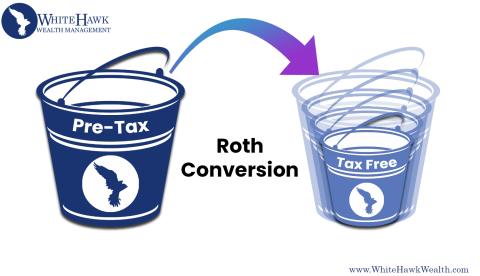
All this talk about Roth… why bother filling the Tax-Free Bucket!? | Tax Planning
The best way to illustrate how conversions have the potential to be impactful is by using hypothetical numbers. Below is a simplified scenario of a pretend couple so that you can see what we see.
Bob and Jane Smith
- Both are 55 years old with life expectancies of 85 (30-year time horizon).
- They both plan to retire at 65.
- Their current income for 2024 is $225,000.
- They are in the 24% Federal tax bracket and their state tax rate is 4.4% (CO)
- We are assuming 6% steady growth in their investment accounts.
- Their goal is to take their accounts to $0 on the day that they both pass.
- We will withhold their taxes on their conversions (NOT IDEAL).
- We are going to assume that the tax rates do NOT change, nor do the brackets or their income.
- They have $600,000 in Traditional IRAs.
For the tax year 2024, the 24% bracket goes up to an income of $383,900. We will convert $158,900 ($383,900 - $225,000) each year to Roth IRAs until the Traditional IRAs are $0, including the 6% growth each year. In year 5, $77,625 will be converted.
Here is the breakdown of the numbers:
WITHOUT CONVERSION | WITH CONVERSION | ||
Balance at Retirement | $1,074,509 | Balance at Retirement | $827,213 |
Maximum Withdrawal | $93,681 | Same NET Withdrawal | $67,075 |
Taxes on Withdrawals | $26,605 | Taxes on Withdrawals | $0 |
Net Payment | $67,075 |
|
|
Ending Balance | $0 | Ending Balance | $185,580 |
Total Taxes Paid | $532,106 | Total Taxes Paid | $202,556 |
The taxes paid on the conversion were paid during the 5 years of conversion and totaled $202,556 versus the taxes paid on the 20 years of withdrawals WITHOUT the conversion totaled $532,106. That’s a difference of just over $330,000 by paying the taxes ahead of time and taking advantage of tax-free growth in the Roth IRA accounts. We will discuss beneficiary IRA rules in another email, but it is also worth noting that the $185,580 left in the Roth IRAs at the end of the plan where we converted the accounts will NOT be taxable to the beneficiaries.
Conclusion of this hypothetical scenario is that there seems to be significant benefits to converting pre-tax funds to Roth. Again, this is a simplified situation with static numbers. Everyone has a different situation, but I think that we can all agree that the fundamentals of having a tax-free bucket are beneficial in almost all circumstances.
Next up: Is there ever a reason to NOT fill the Tax-Free bucket?
Disclosures… we had to load this one up!
This information is not intended to be a substitute for specific individualized tax advice. We suggest that you discuss your specific tax issues with a qualified tax advisor.
This is a hypothetical example and is not representative of any specific situation. Your results will vary. The hypothetical rates of return used do not reflect the deduction of fees and charges inherent to investing.
Contributions to a traditional IRA may be tax deductible in the contribution year, with current income tax due at withdrawal. Withdrawals prior to age 59 ½ may result in a 10% IRS penalty tax in addition to current income tax.
A Roth IRA offers tax deferral on any earnings in the account. Qualified withdrawals of earnings from the account are tax-free. Withdrawals of earnings prior to age 59 ½ or prior to the account being opened for 5 years, whichever is later, may result in a 10% IRS penalty tax. Limitations and restrictions may apply.


